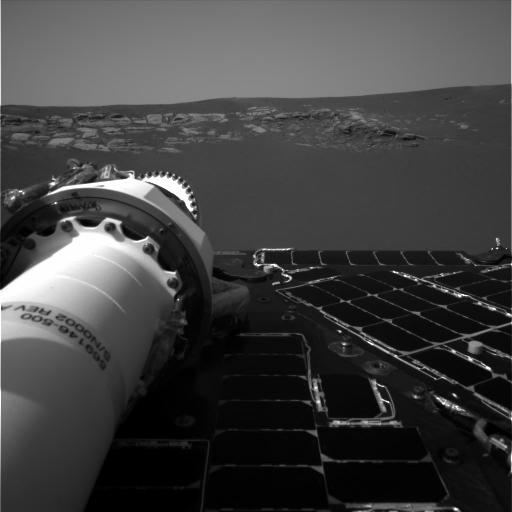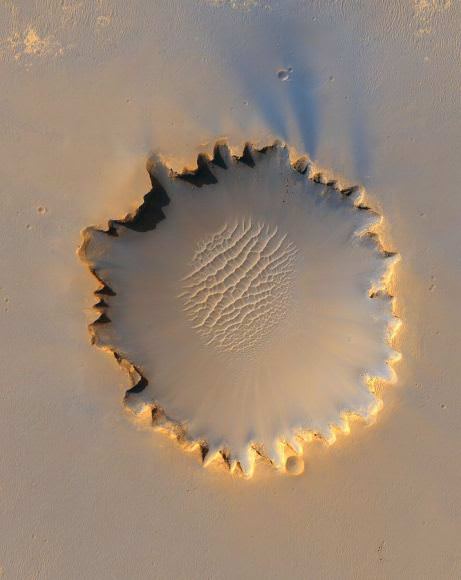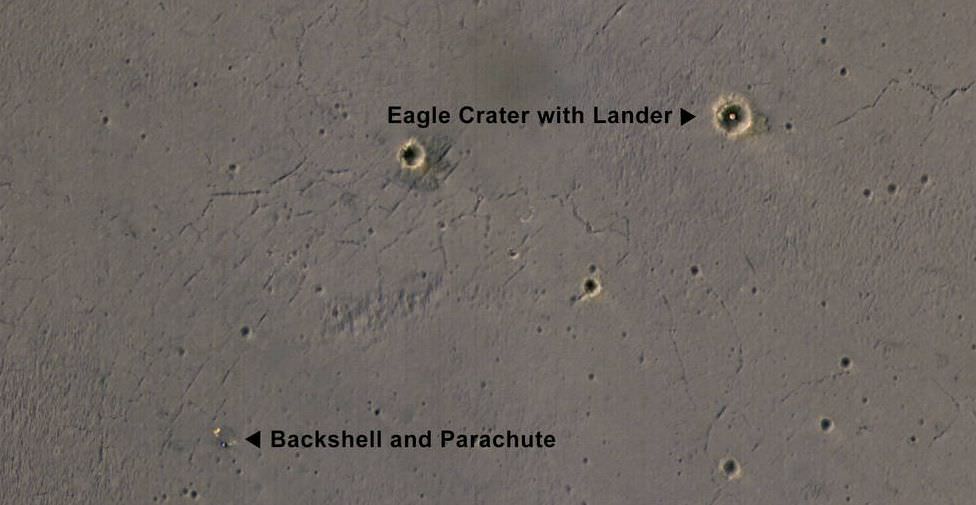NASA’s eagle-eyed Mars Reconnaissance Orbiter (MRO) has captured orbital images of Opportunity’s Hole-In-One landing site, smack dab in the middle of Eagle Crater on the surface of Mars.
Opportunity arrived at Mars on January 25th, 2005. It’s landing was slowed by parachute, and cushioned by airbags. Once it hit the surface, it bounced its way into “Eagle Crater“, a feature a mere 22 meters across. Not a bad shot!
This is the first color image that the High Resolution Imaging Science Experiment (HiRise) has captured of Opportunity’s landing site. It shows the remarkable landing site inside the crater, where the landing pad was left behind after Opportunity rolled off of it and got going. It also shows the rover’s parachute and backshell.
It’s amazing that, given the relatively smooth surface in Opportunity’s landing area, the rover came to rest inside a small crater. When Opportunity “woke up” at its landing site, its first images were of the inside of Eagle Crater. This was the first look we ever got at the sedimentary rocks on Mars, taken by the rover’s navigation camera.

After leaving Eagle Crater, Opportunity took a look back and captured a panoramic image. Plainly visible is the rover’s landing pad, the exposed sedimentary rock, and the rover’s tracks in the Martian soil.

MRO arrived at Mars a couple years later, and by that time Opportunity had already left its landing site and made its way south to the much larger Victoria Crater.

Opportunity is still chugging along, doing valuable work. And so is the MRO and its HiRise instrument. At this point, Opportunity has to be considered one of the most successful scientific undertakings ever.


Looks as if Oppy’s tire tracks have been erased and the parachute quite a bit redder than the first pictures taken back in 05.
Yes.. the tracks were the first thing I looked for!
That was pictured on October 6 2006, 5 sols after Oppy arrived at Victoria crater. The rover is actually visible in the picture, on the rim at “Duck Bay” approximately the 10 o’clock position along the crater rim. The range to the target site was 297 kilometers (185.6 miles). At this distance the image scale is 29.7 centimeters (12 inches) per pixel (with 1 x 1 binning) so objects about 89 centimeters (35 inches) across are resolved.
Full resolution JPG(3.174MB) is available here:
https://photojournal.jpl.nasa.gov/jpeg/PIA08813.jpg
And you can see the tracks from Oppy’s journeys too 😀
I think it would be really cool and provide useful science to send a mission to land next to Spirit’s LZ and retrace her route. Then find her and move her to a more advantageous location/sun angle. Dust off her solar panels and cameras, add jumper cables and battery A/R and use her as a stationary weather station. If she’s totally defunct, it would still provide a lot of science to look at how she and her tracks have weathered over the years and to re-investigate some of her discoveries with newer/better instruments!
Some day anyway.. someone is sure to see Spirit again!